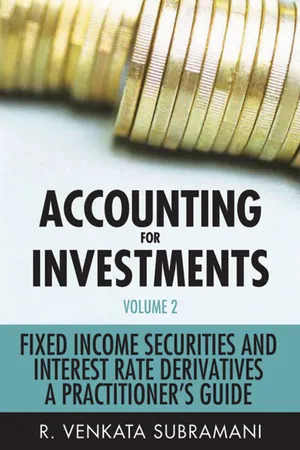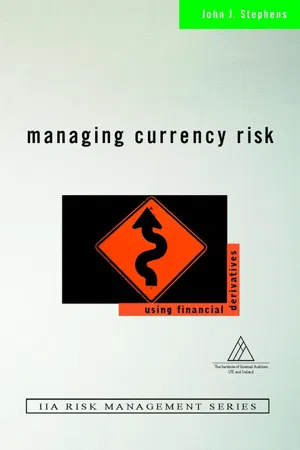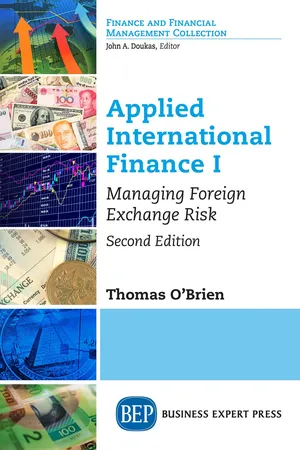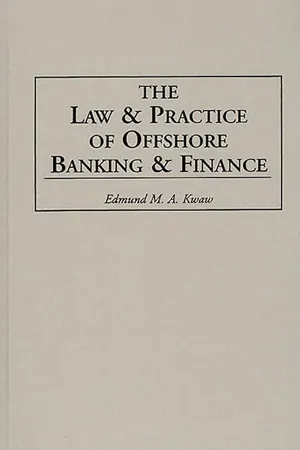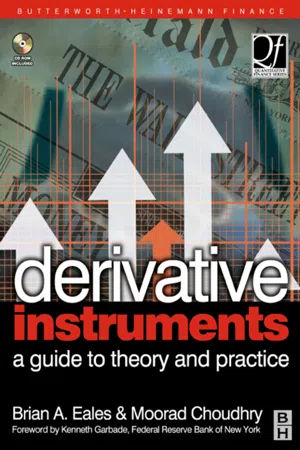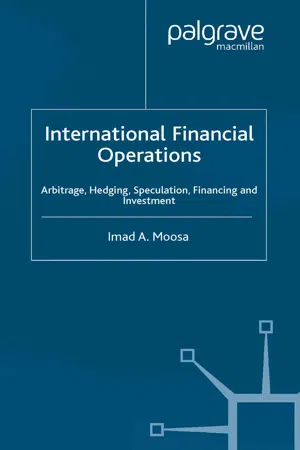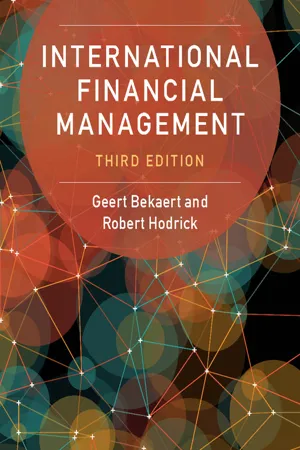Business
Cross Currency Swap
A cross currency swap is a financial agreement between two parties to exchange interest and principal payments in different currencies. This allows each party to access a desired currency without having to engage in foreign exchange transactions. Cross currency swaps are commonly used by businesses to manage currency risk and to secure more favorable borrowing terms in different markets.
Written by Perlego with AI-assistance
Related key terms
1 of 5
10 Key excerpts on "Cross Currency Swap"
- eBook - ePub
Accounting for Investments, Volume 2
A Practitioner's Handbook
- R. Venkata Subramani(Author)
- 2011(Publication Date)
- Wiley(Publisher)
A cross-currency swap is a foreign-exchange contract between two parties to exchange principal and/or interest payments of a loan in one currency for an equivalent loan in another currency. A cross-currency basis swap is an exchange of a fixed or floating rate note in one currency for a fixed or floating rate note in another currency. It may involve swapping payments in one currency for payments in another. At maturity the notional principal may also be swapped.Features of cross-currency swapThe tenure of a cross-currency swap typically ranges from one to fifteen years. Cross-currency swaps are suitable for entities that have loan commitments denominated in one currency, while the revenues generated by the entity are denominated in a different currency, resulting in a currency mismatch between the currency of the loan and the currency of the revenues. Cross-currency swaps are available in different currency pairs. Effectively, a cross-currency swap serves as an excellent hedging strategy for hedgers who wish to protect against both the currency rates as well as interest rate risks.Benefits of a cross-currency swap- A Cross-currency interest rate swap allow an entity to switch its loan from one currency to another.
- A Cross-currency interest rate swap enable an entity to manage foreign currency exposures. With a cross-currency swap the entity can use money it receives in one currency to pay off its loans in another currencycross-currency.
- The entity can focus on raising debt in the domestic market where it has its own strengths and still be able to swap the domestic local currency debt with any foreign currency with a cross-currency swap, thus effectively procuring foreign currency funds at low costs.
- eBook - PDF
Foreign Exchange in Practice
The New Environment
- S. Anthony(Author)
- 2002(Publication Date)
- Palgrave Macmillan(Publisher)
CHAPTER 8 Swaps In this chapter, the concepts of currency and interest rate swaps are intro- duced. Currency swaps provide a powerful tool for manipulating cross currency cash flows without creating a net exchange position. They can be used to roll foreign exchange positions and to simulate foreign currency loans or investments. They can also be used to exploit arbitrage opportuni- ties and to manage banking system liquidity. Interest rate swaps provide a means of switching interest rate exposures between fixed and floating. Cross Currency Swaps can be used when floating interest rates are involved. Definition A currency swap is the simultaneous purchase and sale of equivalent amounts of one currency against another currency for different maturi- ties. A currency swap does not create a net exchange position but it does create mismatched cash flows for a period of time. A currency swap is equivalent to two money market transactions. To illustrate this point, consider the cash flows involved when someone buys Australian dollars spot against US dollars and sells Australian dollars three months forward against US dollars (Exhibit 8.1). EXHIBIT 8.1 Cash flow representation of a currency swap 130 A$ Spot US$ + – A$ 3 months US$ – + The cash flows are the same as when borrowing Australian dollars for three months and lending US dollars for three months. The pricing of the swap must therefore reflect the interest rates applicable to these money market transactions. The direction of the cash flows in the second leg of the swap is the oppo- site of those in the first leg of the swap. Consequently, as with money market transactions, currency swaps create only a temporary mismatch in cash flows. They do not create a net exchange position. TYPES OF CURRENCY SWAP 1. A pure swap is a swap in which both the spot and forward transactions are done simultaneously with the same counterparty. - eBook - PDF
Managing Currency Risk
Using Financial Derivatives
- John J. Stephens(Author)
- 2003(Publication Date)
- Wiley(Publisher)
The discussion on swaps up to this point has demon- strated that currency swaps are flexible instruments that allow tailor-made solutions to be designed for specific situations. It is also evident that currency swaps broaden the scope of forward FX, while maintaining the basic cost structure. There are two types of Cross Currency Swaps, namely cross currency coupon swaps and cross currency basis swaps. The following two case studies will each illustrate the work- ing of one Cross Currency Swap type. case study 9: hedging foreign currency receivable with a cross currency coupon swap scenario A US based international pharmaceutical company, US Pharmaceuticals, has a subsidiary company in Switzerland, Suisselab SA. In order to finance large-scale improvements to the subsidiary company’s laboratories in Geneva, the US parent company is investing $250 million in its subsidiary, partly by taking up stock and partly through a SFr.130 million interest bearing loan. The loan is repayable in 3 years time. CURRENCY SWAPS 118 Figure 5-2 The cash flows in a 5-year foreign currency payable currency swap. The Swiss company will service the loan by making interest payments quarterly in arrears calculated using 3 month CHF LIBOR. The interest rate for each quarter is fixed advance. When the transaction is structured, the USD/CHF spot exchange rate is SFr.1.7692/$ and CHF 3 month LIBOR is 3.5550%. However, Swiss Bank is quoting the exchange rate at SFr.1.7648–1.7736/$. The US money market interest rate is 6.56%, while the Swiss rate is 3.2%. currency and interest rate risk The primary currency risk faced by US Pharmaceuticals is that the Swiss Franc may depreciate against the US dollar during the term of the loan. This will influence not only the dollar value of the principal when it is repaid in 3 years time, but also the dollar value of the interest payments received. - eBook - PDF
- Alan C. Shapiro, Peter Moles(Authors)
- 2014(Publication Date)
- Wiley(Publisher)
3 Swaps also allow firms that are parties to the contracts to lower their cost of foreign exchange risk management by arbitraging their relative access to different currency markets. A borrower whose securities are much in demand in one currency can obtain a cost saving in another currency sector by raising money in the former and swapping the funds into the latter currency. A company in the Eurozone, for example, may want to secure fixed-rate funds in Australian dollars in order to reduce its Australian dollar exposure, but it may be hampered in doing so because it is a relatively unknown credit in the Australian financial market. In contrast, an Australian company that is well established in its own country may desire floating-rate euros financing but is relatively unknown in the European financial market. In such a case, a bank intermediary familiar with the funding needs and “comparative advan- tages” in borrowing of both parties may arrange a currency swap. The Eurozone company borrows floating-rate euros, and the Australian company borrows fixed-rate Australian dollars. The two com- panies then swap both principal and interest payments. When the term of the swap matures, say, in five years, the principal amounts revert to the original holder. Both parties receive a cost savings because they initially borrow in the market in which they have a comparative advantage and then swap for their preferred liability. In general, currency swaps allow the parties to the contract to arbi- trage their relative access to different currency markets. A borrower whose securities are much in demand in one currency can obtain a cost saving in another currency sector by raising money in the former and swapping the funds into the latter currency. Currency swaps are, therefore, often used to provide long-term financing in foreign currencies. - eBook - ePub
- Thomas J. O'Brien(Author)
- 2017(Publication Date)
- Business Expert Press(Publisher)
CHAPTER 6Currency Swaps“The advent of swaps, as much as anything else, helped transform the world’s segmented capital markets into a single, truly integrated, international capital market.”—John F. Marshall and Kenneth R. Kapner (1993)A currency swap is a contract to exchange two streams of future cash flows in different currencies. Currency swaps were initially designed to circumvent capital controls imposed by governments and to make borrowing more efficient in global markets. We will see that currency swaps are used to convert debt denominated in one currency into “synthetic” debt denominated in another currency. Synthetic debt created in this way sometimes allows a segment of the capital market to be tapped that would otherwise not be accessible with actual debt denominated in that currency. By themselves, moreover, currency swaps are useful in managing FX business exposure in situations where foreign currency net debt is not practical.World Bank—IBM SwapThe first currency swap seems to be a 1981 transaction between the World Bank and IBM. Its details are instructive. The World Bank wanted to raise additional capital by issuing new debt and to denominate the debt payments in Swiss francs because of a low market interest rate in that currency. The U.S. bond market, though, was more receptive to World Bank bonds than was the Swiss bond market, because the World Bank had already saturated the Swiss market’s “appetite” for its bonds, and U.S. investors regarded World Bank bonds to have much less credit risk than Swiss investors did. However, the U.S. investors wanted bonds denominated in US dollars.At the same time, IBM had previously financed by issuing some Swiss franc debt, but had since developed the view that the Swiss franc was undervalued, and thus was likely to appreciate abnormally relative to the US dollar. IBM thus wanted to replace its Swiss franc debt with US dollar debt. But issuing new US dollar bonds and using the proceeds to repurchase the Swiss franc bonds would be relatively expensive in terms of transaction costs. - Edmund Kwaw(Author)
- 1996(Publication Date)
- Praeger(Publisher)
8.00[2][ii] Currency Swap-Driven Financing The currency swap, also referred to as the fixed rate currency swap, involves the exchange of liabilities in two different currencies. The counterparties agtee to exchange principal and interest loan payments in one currency for another currency at a fixed exchange rate, usually the currency spot rate. 11 This basic currency swap can be divided into three stages: the initial exchange of princi- pals, the interim ongoing exchanges of interest, and the final re-exchange of principals. It is useful to illustrate the nature of these stages using a hypothetical example. A Ltd. possesses a 100 million sterling liability as a result of the issue of eurobonds, but desires a liability in U.S. dollars, and that B Ltd. also possesses a U.S.$200 million liability as a result of the issue of bonds, but would prefer a sterling liability. The parties can meet their needs by engaging in a currency swap. Swap-Driven Financing in the Eurocurrency Market 179 Figure 8.3 The Structure of an Interest Rate Swap At the beginning of the transaction, the counterparties swap the principal amounts concerned at the agreed upon exchange rate, usually the current spot exchange rate. 12 The initial exchange of principals may either be a notional exchange or a physical exchange. 13 The objective behind this initial exchange is to establish the value of the respective principal amounts to enable the computation of the subsequent interest payments and the re-exchange of principal amounts at maturity. Once the initial exchange or swap of principals has been made, interest payments are exchanged in the interim on an ongoing basis. The value of the interest payments is determined by the principal amounts outstanding at the agreed fixed rate of interest. Finally, at maturity, the principal amounts which were established at the beginning of the transaction are re-exchanged. The nature of the cash flows involved is illustrated in Figure 8.4.- eBook - PDF
Derivative Instruments
A Guide to Theory and Practice
- Brian Eales, Moorad Choudhry(Authors)
- 2003(Publication Date)
- Butterworth-Heinemann(Publisher)
Where currencies are exchanged at the start of the swap, at the prevailing spot exchange rate for the two currencies, the exact amounts are exchanged back on maturity. During the time of the swap, the parties make interest payments in the currency that they have received where principals are exchanged. It may seem that exchanging the same amount on maturity gives rise to some sort of currency risk, in fact it is this feature that removes any element of currency risk from the swap transaction. Currency swaps are widely used in association with bond issues by borrowers who seek to tap opportunities in different markets but have no requirement for that market's cur-rency. By means of a currency swap, a company can raise funds in virtually any market and swap the proceeds into the currency that it requires. Often the underwriting bank that is responsible for the bond issue will also arrange for the currency swap to be transacted. In a currency swap therefore, the exchange of principal means that the value of the principal 88 Derivative Instruments amounts must be accounted for, and is dependent on the prevailing spot exchange rate between the two currencies. 6.4.1 Valuation of currency swaps The same principles we established for the pricing and valuation of interest rate swaps may be applied to currency swaps. A generic currency swap with fixed-rate payment legs would be valued at the fair value swap rate for each currency, which would give a net present value of zero. The cash flows are illustrated in Figure 6.3. This shows that the two swap rates in a fixed±fixed currency swap would be identical to the same-maturity swap rate for each currency interest rate swap. So the swap rates for a fixed±fixed five-year sterling/dollar currency swap would be the five-year sterling swap rate and the five-year dollar swap rate. - eBook - PDF
International Financial Operations
Arbitrage, Hedging, Speculation, Financing and Investment
- I. Moosa(Author)
- 2003(Publication Date)
- Palgrave Macmillan(Publisher)
However, because of the risk involved, banks only offer these contracts to the most creditworthy customers. Currency swaps Swaps are suitable for hedging a recurrent exposure that consists of a series of payables or receivables. A currency swap resembles a portfolio of forward contracts, whereby two parties agree to exchange two cash flows denomi- nated in two different currencies at a predetermined exchange rate on a sequence of future dates. Suppose that a firm whose base currency is x anticipates a series of receiv- ables (K units of y) arising at points in time 1, 2, 3, ..., n. To hedge this exposure, the firm arranges a swap with a counterparty whereby the firm receives payments in terms of x equal to K converted at the contract rate, S t , while the counterparty receives K units of y. Table 5.8 shows the payments received by the firm and the counterparty at each payment period in both currencies. 5 . 8 F I N A N C I A L H E D G I N G O F L O N G - T E R M E X P O S U R E 137 Payment date The firm receives The counterparty receives Units of x Units of y Units of x Units of y 1 KS t K KS t +1 K 2 KS t K KS t +2 K 3 KS t K KS t +3 K n KS t K KS t n + K TABLE 5.8 Payments involved in a currency swap. Parallel loans Parallel loans (or back-to-back loans) can be used to hedge long-term payables and receivables in exactly the same way as swaps. In this case, however, the exchanged payments are based on the forward rates. 5.9 OTHER FINANCIAL AND OPERATIONAL TECHNIQUES OF HEDGING TRANSACTION EXPOSURE It may not be possible to implement the hedging techniques discussed so far. This may be due, for example, to the inability to forecast the sales resulting from an advertised reduction in prices over the following six months. Another reason is that the hedging costs may be prohibitively high. A third reason is the unavailability of forward, futures or options contracts for the underlying currency. When this is the case the following techniques may be considered. - eBook - PDF
Fundamentals of Financial Instruments
An Introduction to Stocks, Bonds, Foreign Exchange, and Derivatives
- Sunil K. Parameswaran(Author)
- 2022(Publication Date)
- Wiley(Publisher)
In our illustration, therefore, we will assume that Bank Atlantic will make a payment of 6MM euros to Bank Europeana after two years, in exchange for a cash flow of 7.50MM dollars. Such a swap where the same amount of principal is exchanged is known as a par swap . 5 ▪ At the end of two years Bank Atlantic would use the dollars received by it to repay the US dollar–denominated loan that it had taken two years prior. ▪ Bank Europeana would use the euros received by it to repay the loan that it had taken in Frankfurt two years earlier. As can be perceived from the illustration, a swap transaction such as this enables each party to service the debt of the counterparty. Bank Atlantic has taken a dollar-denominated loan. It will service it using the dollar-denominated payments that it receives every six months from Bank Europeana. Similarly, Bank Europeana has taken a loan denominated in euros, which it will service using the euro-denominated payments it receives periodically from Bank Atlantic. CROSS-CURRENCY SWAPS Technically speaking the term currency swap is applicable only for transactions that entail the exchange of cash flows computed on a fixed-rate–fixed-rate basis, such as the deal that we have just studied. Currency swaps where one or both payments are based on a floating rate of interest should strictly speaking be termed as cross-currency swaps. Within cross-currency swaps, we make a distinction between coupon swaps that are on a fixed-rate–floating-rate basis and basis swaps on a floating-rate–floating-rate basis. VALUATION We will explore the mechanics of currency swap valuation by focusing on the swap between Bank Atlantic and Bank Europeana. The swap may be viewed as a combina-tion of the following transactions. Assume that Bank Atlantic has issued a fixed-rate 5 See Geroulanos (1998). 428 SWAPS bond in euros with a principal of €6MM and converted the proceeds to dollars at the spot rate of 0.8000 USD-EUR. - eBook - PDF
- Geert Bekaert, Robert Hodrick(Authors)
- 2017(Publication Date)
- Cambridge University Press(Publisher)
The financial intermediary would arrange the swap, act as coun- terparty for both firms, and walk away with a handsome profit. Exhibit 21.8 demonstrates how the cash flows for a currency swap could be struc- tured for Goodweek, Bridgerock, and Bank Carribus. Exhibit 21.9 provides a summary diagram of the cash flows and the all-in costs. The currency swap begins with each firm issuing bonds denominated in the currency in which it has a comparative bor- rowing advantage: Goodweek issues a dollar-denominated bond to investors, and Bridgerock issues a euro-denominated bond to investors. Bank Carribus wants each firm to make the interest and principal payments associ- ated with the bond issue of the other company in return for receiving cash flows that are equivalent to the interest and principal payments that each firm owes its bond- holders. What must be determined is how much money will change hands initially, at the beginning of the swap. This initial transfer determines the all-in costs of the swap to each company. If it participates in the currency swap, Goodweek receives dollar interest and prin- cipal from Bank Carribus that exactly match the cash flows that Goodweek owes its bondholders. In return, Goodweek pays Bank Carribus the sequence of euro cash flows associated with Bridgerock’s bond issue. Bank Carribus then gives these euro cash flows to Bridgerock, and Bridgerock makes the dollar interest and principal payments to Bank Carribus that are equivalent to the cash flows associated with Goodweek’s dollar debt.
Index pages curate the most relevant extracts from our library of academic textbooks. They’ve been created using an in-house natural language model (NLM), each adding context and meaning to key research topics.
